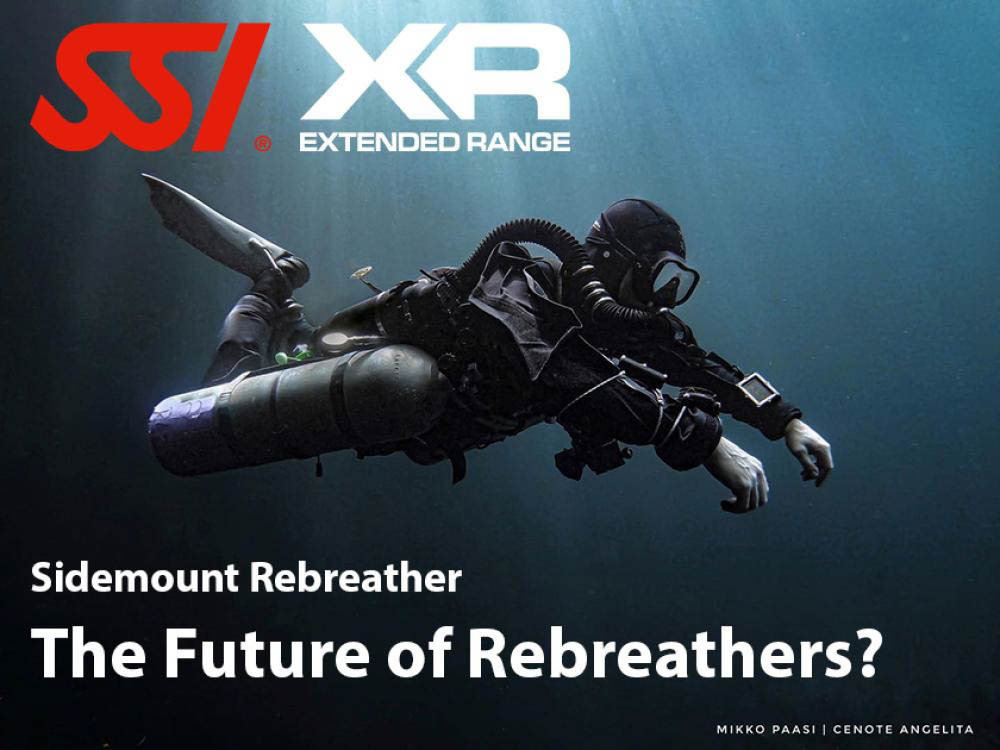Open-circuit sidemount diving has seen a large growth over the last few years. The demand for sidemount rebreathers was always going to be a natural progression. More manufacturers are designing and producing sidemount rebreathers as the interest in this equipment configuration develops. The multiple applications and flexibility of this configuration is very appealing. Divers who are sidemount diving as their primary configuration often do not want to dive in a backmount configuration. Their diving style, skill set, and experience have evolved to suit sidemount diving.
To understand where the first sidemount rebreathers came from we must discuss dual rebreathers. Pioneering cave diver Jochen Hasenmayer made some experimental dives with a Speleo-Twin rebreather (STR-80) as early as 1981. In 1987, Dr Bill Stone spent 24 hours underwater on a dual CCR called the “Failsafe Rebreather for Exploration Diving”. Olivier Isler made the first actual exploration dives in 1990. He used a triple RI2000 semi-closed rebreather to explore the Emergence du Ressel in Lot, France. Most of these rebreather units were backmounted.
Many divers have been building dual rebreather systems out of standard backmount rebreathers since then. These rebreather units have had some interesting names like the dual Megalodon rebreather called the “Doubleodon” or the dual AP Inspiration named the “Twinspiration”. These rebreather units were not engineered by manufacturers but created to meet the specific demands of the divers who used them. Krzysztof Starnawski was using a “Double Hammerhead” in Egypt to complete some deep rebreather dives to depths of 222 meters. He set the world record for closed-circuit diving in December 2011 by diving to 283 meters.
Dual rebreathers are used to extend the duration of the dive by using both rebreathers for a decompression duration that would exceed a single rebreather. Although these rebreathers were capable, they were often bulky and required complicated procedures like breathing from each breathing loop repeatedly to ensure that both were functioning. As space was at a premium some of these rebreathers became configured as sidemount or removable like stage cylinders.
Development
The first dedicated sidemount rebreather for sport divers appeared in 2006. Scuba Force were working with the SF1 PSCR to enable the company’s owners to explore the Baltic Sea. The first commercially available CCR was around 2014 with the Flex CCR. It was designed to be used as backmount, sidemount, or no mount. In 2016, the KISS Sidekick and KISS Sidewinder were developed and in 2018, divers used the Halcyon RBK to resurvey and explore more than 180,000 meters of cave passage in Ox Bel Ha, Mexico.
A sidemount rebreather changes the diver’s profile in the water making them streamline and flexible. The rebreather is capable of being removing and/or manipulated underwater which is an advantage in an overhead environment when passages or tunnels become tight and twisty. Moving the equipment into hard to reach locations can be done in stages as gas is carried separate from the rebreather.
Recent times have seen more small scale manufacturers join the diving equipment market. With more ideas and cheaper Eastern European production, they have more than doubled the amount of sidemount rebreathers available in 5 years.
Sidemount rebreathers currently on the market:
- Kiss Sidewinder
- Scuba Force SF2
- Divesoft Liberty
- Flex CCR
- T-Reb
- Submatix SMS 200
- Halcyon RBK
Uses for Sidemount Rebreathers
Sidemount rebreathers fulfill multiple roles based on the goals and philosophies of the divers that use them. Some of these configurations include:
- Primary sidemount rebreather, backup open circuit twinset
- Primary sidemount rebreather, backup open circuit sidemount
- Primary sidemount rebreather, backup sidemount rebreather
- Primary sidemount rebreather, backup backmount rebreather
- Primary backmount rebreather, backup sidemount rebreather
- Primary sidemount rebreather, backup sidemount rebreather
- Dual backmount rebreather, single or multiple sidemount rebreather
- Any configuration with staged backup sidemount rebreather(s)
Bailout Rebreather
The bailout rebreather has originated from the dual rebreather community. If the primary rebreather fails, the bailout rebreather provides a fully redundant system, allowing the diver to exit the water completing the same obligations with minimal gas usage as if the primary system was still functioning. Bailout rebreathers are suited to extreme dives where open-circuit bailout has reached its limits.
Note: Sidemount rebreathers are often closely linked with chest-mounted rebreathers. Much of what applies to sidemount rebreathers applies to chest-mounted rebreathers.
The Future of Sidemount Rebreathers
Training agencies have currently not agreed on what the content for sidemount rebreather training should be due to the variation in the units. Divers are still debating the best way to put the technology safely to work.
At the time of writing no sidemount rebreather has received a CE certification for the sidemount design. Many manufacturers quote the backmount CE to indicate the sidemount is CE certified but the reality is far from that. The rigors of CE testing are proving to be too great or too expensive for the small-scale manufacturers. SSI supports development is always looking towards the future. As this configuration develops and units gain a CE rating SSI will be ready to add sidemount rebreather into their training.







